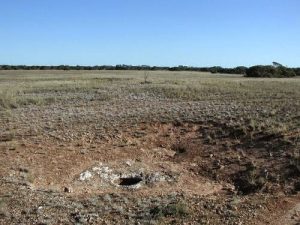
La Trobe University expert says Dr Shannon Burnett says he had always thought of the Nullabor Plain as “just a big desert”.
“However, as I started studying and collecting data for my honors project in 2011, I became intrigued as flank margin caves [forming on margins of enclosing ridges] are normally found on islands, but this is the first time they have been found on a continental setting,” he says.
Dr Burnett has been gathering data on the region’s blowholes with the help of the Victorian Speleological Society.
They carried out aerial surveys and subsequent ground confirmation expeditions and also considered data collected from previous surveys carried out by the Western Australian Cavers.
Dr Burnett found the blowholes in two bands, one along the coast and the other about 75km inland, in a 25−30km wide band incorporating 1,307 features.
He believes the cave porosity is much greater than the blowhole density because the blowholes blow draughts of up to 70km/h indicating they are connected by extensive cave systems of small un-enterable passages.
He says the blowhole draughts are caused by barometric pressure and not tidal influences.
Air survey uncovers blowholes
“We chose areas to survey that we believed had a high density of features or had one or more significant features,” Dr Burnett says.
“I had the use of a retired pilot with an ultra-light aircraft who flew in a systematic pattern so that the whole search area could be covered.
“When the pilot spotted a blowhole, he marked the position with a GPS for the ground team to physically verify and accurately locate.
“Because of accessibility issues on the Nullarbor, previous data [was] biased around roads and the Trans-Continental railway, however the systematic coverage of the large and defined search areas by the ultra-light aircraft has almost eliminated bias.”
Dr Burnett says it was too difficult to access and explore the Nullarbor’s northern regions and satellite imagery wasn’t an option as he didn’t have the budget for paid satellite imagery and the blowholes are too small to be seen on free satellite services.
He says more surveys and expeditions will be conducted, especially as these flank margin caves represent an unrecognised potential petroleum reservoir.
Note : The above story is based on materials provided by Science Network WA










